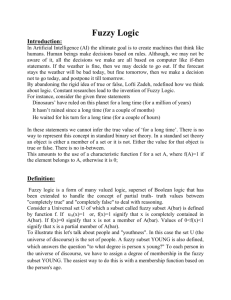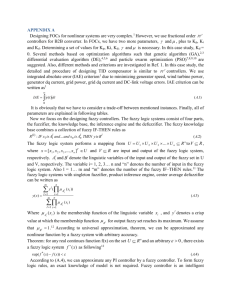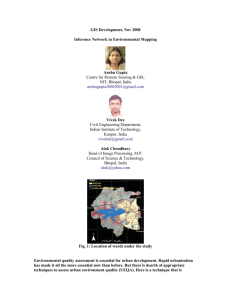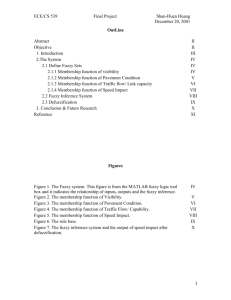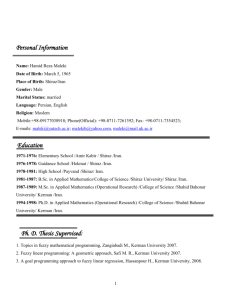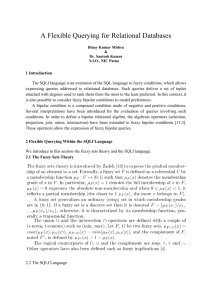- International Research Symposium on Engineering
advertisement
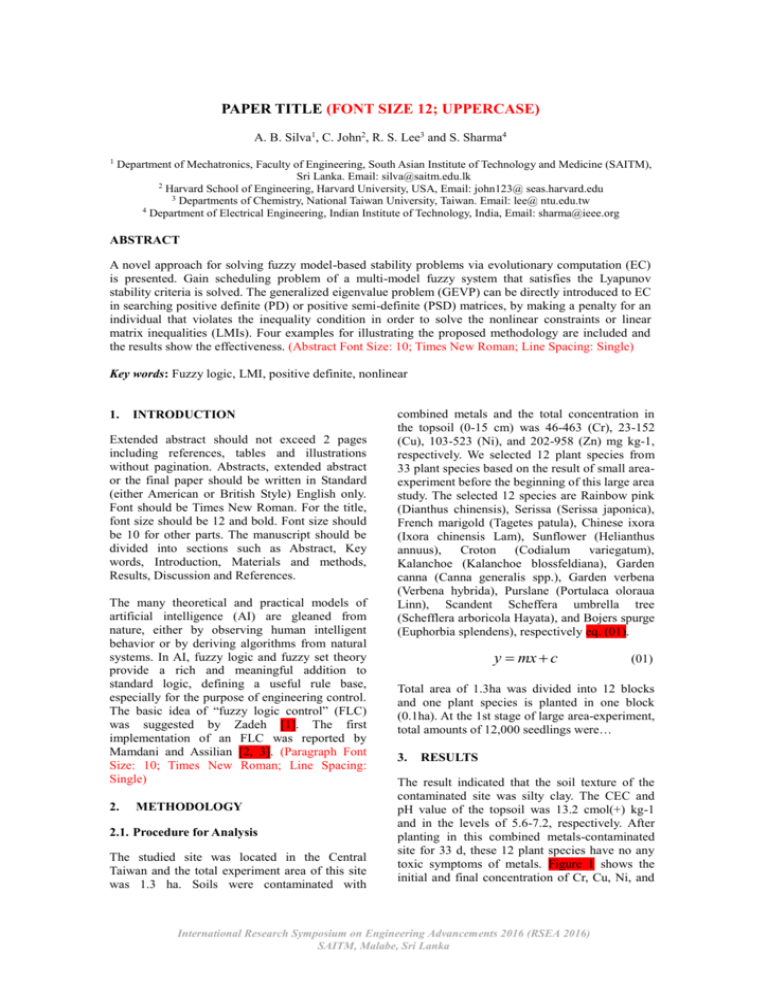
PAPER TITLE (FONT SIZE 12; UPPERCASE) A. B. Silva1, C. John2, R. S. Lee3 and S. Sharma4 1 Department of Mechatronics, Faculty of Engineering, South Asian Institute of Technology and Medicine (SAITM), Sri Lanka. Email: silva@saitm.edu.lk 2 Harvard School of Engineering, Harvard University, USA, Email: john123@ seas.harvard.edu 3 Departments of Chemistry, National Taiwan University, Taiwan. Email: lee@ ntu.edu.tw 4 Department of Electrical Engineering, Indian Institute of Technology, India, Email: sharma@ieee.org ABSTRACT A novel approach for solving fuzzy model-based stability problems via evolutionary computation (EC) is presented. Gain scheduling problem of a multi-model fuzzy system that satisfies the Lyapunov stability criteria is solved. The generalized eigenvalue problem (GEVP) can be directly introduced to EC in searching positive definite (PD) or positive semi-definite (PSD) matrices, by making a penalty for an individual that violates the inequality condition in order to solve the nonlinear constraints or linear matrix inequalities (LMIs). Four examples for illustrating the proposed methodology are included and the results show the effectiveness. (Abstract Font Size: 10; Times New Roman; Line Spacing: Single) Key words: Fuzzy logic, LMI, positive definite, nonlinear 1. INTRODUCTION Extended abstract should not exceed 2 pages including references, tables and illustrations without pagination. Abstracts, extended abstract or the final paper should be written in Standard (either American or British Style) English only. Font should be Times New Roman. For the title, font size should be 12 and bold. Font size should be 10 for other parts. The manuscript should be divided into sections such as Abstract, Key words, Introduction, Materials and methods, Results, Discussion and References. The many theoretical and practical models of artificial intelligence (AI) are gleaned from nature, either by observing human intelligent behavior or by deriving algorithms from natural systems. In AI, fuzzy logic and fuzzy set theory provide a rich and meaningful addition to standard logic, defining a useful rule base, especially for the purpose of engineering control. The basic idea of “fuzzy logic control” (FLC) was suggested by Zadeh [1]. The first implementation of an FLC was reported by Mamdani and Assilian [2, 3]. (Paragraph Font Size: 10; Times New Roman; Line Spacing: Single) 2. METHODOLOGY 2.1. Procedure for Analysis The studied site was located in the Central Taiwan and the total experiment area of this site was 1.3 ha. Soils were contaminated with combined metals and the total concentration in the topsoil (0-15 cm) was 46-463 (Cr), 23-152 (Cu), 103-523 (Ni), and 202-958 (Zn) mg kg-1, respectively. We selected 12 plant species from 33 plant species based on the result of small areaexperiment before the beginning of this large area study. The selected 12 species are Rainbow pink (Dianthus chinensis), Serissa (Serissa japonica), French marigold (Tagetes patula), Chinese ixora (Ixora chinensis Lam), Sunflower (Helianthus annuus), Croton (Codialum variegatum), Kalanchoe (Kalanchoe blossfeldiana), Garden canna (Canna generalis spp.), Garden verbena (Verbena hybrida), Purslane (Portulaca oloraua Linn), Scandent Scheffera umbrella tree (Schefflera arboricola Hayata), and Bojers spurge (Euphorbia splendens), respectively eq. (01). y mx c (01) Total area of 1.3ha was divided into 12 blocks and one plant species is planted in one block (0.1ha). At the 1st stage of large area-experiment, total amounts of 12,000 seedlings were… 3. RESULTS The result indicated that the soil texture of the contaminated site was silty clay. The CEC and pH value of the topsoil was 13.2 cmol(+) kg-1 and in the levels of 5.6-7.2, respectively. After planting in this combined metals-contaminated site for 33 d, these 12 plant species have no any toxic symptoms of metals. Figure 1 shows the initial and final concentration of Cr, Cu, Ni, and International Research Symposium on Engineering Advancements 2016 (RSEA 2016) SAITM, Malabe, Sri Lanka Zn in the shoots of 12 plant species. Except for Cu concentration of Chinese ixora and Purslane in shoot, the other 10 plant species have low metal concentration before planting (initial in Fig. 1). The initial metal concentration in their shoots was <20 (Cr), <10 (Cu), <5 (Ni), and <50 (Zn) mg kg-1, respectively. Based on the experimental results and conditions of this study (10,000 plants/ha/species), we can probably calculate the total phytoextraction capacity of different metals. Figure 1 shows experience of an individual's state of mind as interacting with biochemical (internal) and environmental (external) influences. Moreover, Table 1 shows the values of the experiment 1. addition to those, one of the advantages of this algorithm is that the LMIs of the fuzzy modelbased controller scheme can be directly solved without using any particular software tool for solving LMIs. On the other hand, any of EC algorithms produces a sub-optimal solution and we may not even know whether it has a solution or not. 5. REFERENCES [1] L. A. Zadeh, “Fuzzy Sets,” Journal of Information and Control, vol. 8, pp. 338-353, 1965. [2] E. H. Mamdani, "Fuzzy sets, 20 years of fuzzy control: experiences gained and lessons learnt," in: Proceedings of IEEE International Conference on fuzzy systems, pp. 339–344, 1993. [3] A. Jadbabaaie, “Robust, Non-Fragile Controller Synthesis Using Model-Based Systems: A Linear Matrix Inequality Approach,” Master Thesis, University of Mexico, USA, October 1997. [4] X. Ma, Z. Sun, and Y. He, “Analysis and Design of Fuzzy Controllers and Observers,” IEEE Transactions on Fuzzy Systems, vol. 6, no. 1, pp. 41–51, 1998. [5] L. A. Zadeh, “Fuzzy logic,” IEEE Computer Magazine, pp. 83–93, 1988. (Reference List Font Size: 10; Times New Roman; Line Spacing: Single) Figure 1: State of mind as interacting with biochemical (Figure Caption Font Size: 9; Times New Roman; Line Spacing: Single; bold) Table 1: Title…(Table Caption Font Size: 9; Times New Roman; Line Spacing: Single; bold) Sample 1 1 2 4. State Active Neutral Value 12.3 [J/m2] - CONCLUSION An EC based algorithm has a number of advantages. It can quickly scan a vast solution set. Moreover, this EC approach is appropriate for handling any number of constraints of the control system, in addition to the stability criteria guaranteed by the Lyapunov non-linear constraints or LMIs. For an example, if the designer wants to keep the gains at high (or law) it can be easily achieved by setting upper and lower limits of the genes of EC program. In International Research Symposium on Engineering Advancements 2016 (RSEA 2016) SAITM, Malabe, Sri Lanka






